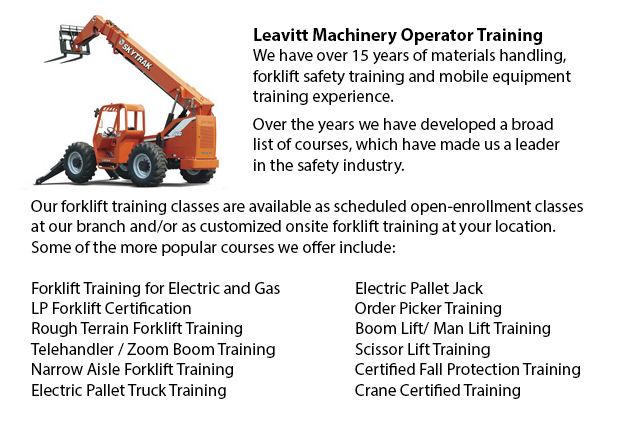
Ottawa Telehandler License - The telescopic handler or telehandler is a commonly used machine in industrial and agricultural applications. This machine is similar in look to a forklift and also works in a similar manner, even if telehandlers are much more like a crane than forklift. It has a telescopic boom which can extend upward and forwards from the motor vehicle. The boom has the capability to fit one of various accessories including muck grab, pallet forks, a bucket or a lift table.
The most common telehandler attachments are pallet forks. The telehandler is used to transport items in situations where the loads cannot be moved by a conventional lift truck. Telehandlers are specially useful for placing loads on rooftops for example, or for removing palletized cargo from with a trailer. A lot of the jobs that a telehandler could complete will otherwise require a crane and this piece of equipment can be expensive, not always time efficient and impractical.
Because the boom raises or extends while bearing a load, it likewise acts as a lever. Despite the counterweights in the back, this causes the machine to become ever more unstable; hence, the advantage of the telehandler is actually its greatest limitation. As the working radius increases, the lifting capacity decreases. The working radius is defined as the distance between the center of the load and the front of the wheels.
Like for example, a telehandler with a 5000 lb capability with the boom retracted can safely lift as little as 400 lb once it is completely extended at a low boom angle. The equivalent machine which has a 5000 lb lift capacity and the boom retracted could support as much as 10,000 lb with the boom raised to 70 degrees. The operator has a load chart to help determine whether a certain lifting job can be completed in a safe and efficient way. This chart takes into account the boom angle, the weight and height.
Several telehandlers come equipped together with a computer that utilizes sensors in order to monitor the vehicle. These sensors will warn the operator and some are capable of cutting off further control input if the limits of the vehicle are exceeded. Some telehandler models are also outfitted together with front outriggers which are referred to as mobile cranes. These greatly extend the lifting capability of the equipment while it is stationary.
-
Ottawa Boom Lift Ticket
Ottawa Boom Lift Ticket - Boom Lifts are a table lift piece of equipment which could be lifted or lowered to varying heights, making this apparatus a useful tool for many manufacturing purposes. There are some unique types of Boom Lift consisting of... More -
Ottawa Boom Lift Operator Training
Ottawa Boom Lift Operator Training - The cherry picker work platform is a kind of work platform, which will typically have a bucket or platform at the hydraulic lifting system's end. The device is also referred to as a man lift, boom lift, basket cra... More -
Aerial Lift / Boom Lift / Man Lift / Scissor Lift Training in Ottawa
Scissor lifts are forklift tables which raise objects and people and supplies vertically. They are normally utilized in industrial, construction and commercial environments. A common use of scissor lifts is for lifting or lowering construction suppli... More -
Ottawa Crane Certification
Ottawa Crane Certification - The Crane Certification training program covers content suggested by industry concerning the safe and efficient operation of cranes. Individuals training would know the following: pre-operational, operational and post ope... More -
Ottawa Heavy Equipment Training Courses
Ottawa Heavy Equipment Training Courses - The first step required to take when selecting heavy equipment operator courses is determining the capacity you wish to work with heavy machinery. Like for example, you can take courses that will teach you ho... More -
Ottawa Fall Protection Ticket
Ottawa Fall Protection Ticket - Fall-related accidents are the number one reason of death in the construction trade. The potential for fall accidents very much increases based on the kind of work which is being completed within your workplace. So, be... More -
Ottawa Telehandler Operator Training
Ottawa Telehandler Operator Training - Telescopic handler Forklifts or telehandler forklifts are common industrial machinery seen in various construction business settings. The telehandler is a useful machine and makes for a valuable tool that can be... More -
Fall Protection Training in Ottawa
Regrettably, there is a large number of workplace injuries linked to falling and lots of fall-related deaths reported each year. Lots of these instances might have been prevented by having proper measures in place, offering proper training and equipp... More

Forklift Certification Ottawa
TOLL FREE: 1-888-254-6157
Ottawa, Ontario
forkliftcertificationottawa.com
Email Us
About Us


